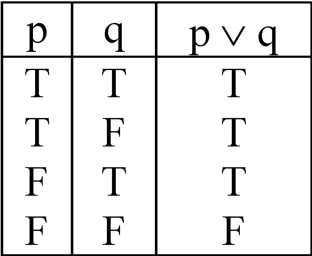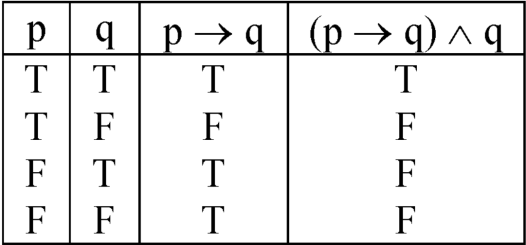Unit-1
Mathematical Logic
Q1) Obtain the truth value of the disjunction of ‘The earth is flat’. and ‘3 + 5 = 2’.
A1)
Let p denote ‘The earth is flat,’ and q denote ‘3 + 5 = 2’. Then we know that the truth values of both p and q are F. Therefore, the truth value of p ∨ q is F.
Q2) Let p: 5 + 2 = 7, q: 9 + 2 = 10 then p ∨q: 5 + 2 = 7 or 9 + 2 = 10
A2)
Truth table for disjunction-

Q3) Obtain the truth value of the conjunction of ‘2 ÷5 = 1’ and ‘Ramesh is in Jaipur’.
A3)
Let p: 2 ÷5 = 1, and
q:Ramesh is in Jaipur.
Then the truth value of p is F. Therefore, from Table 3 you will find that the truth
Value of p ∧ q is F.
Q4) Define conditional connectives
A4)
Given any two propositions p and q, we denote the statement ‘If p, then q’ by
p→ q. We also read this as ‘p implies q’. or ‘p is sufficient for q’, or ‘p only if q’. We also call p the hypothesis and q the conclusion. Further, a statement of the form p → q is called a conditional statement.
Truth table for implication-

Q5) Show that p ∨~p is a tautology.
A5)
First we will construct the truth table for (p ∨~p)
P |
| (p ∨~p) |
T | F | T |
T | T | T |
p∨~p is always true.
Hence p ∨~p is a tautology.
Q6) Verify that p ∧q ∧~ p is a contradiction and p →q ↔~ p ∨q is a tautology.
A6)
Let us draw the truth tables of these two propositions-

Looking at the fifth column of the table, you can see that p ∧q ∧~p is a contradiction.
p→q ↔~ p ∨q is a tautology
Q6) Show that
(p∧(~p ∨q)) ∨(q ∧~ (p ∧q) ≡q
A6)
L.H.S.
(p∧(~p ∨q)) ∨(q ∧~ (p ∧q)
≡((p ∧~p) ∨(p ∧q)) ∨(q ∧(~p ∨~q))
≡f∨(p ∧q) ∨(q ∧~p) ∨(q ∧~p) ∨(q ∧~q) where(p ∧~p = f )
≡(p ∧q) ∨(q ∧~p) ∨f
≡(p ∧q) ∨(q ∨~p)
≡(q ∧p) ∨(q ∨~p)
≡q∧(p ∨~p)
≡q∧(p ∨~p)
≡q∧t where (_ p ∨~p = t)
≡q
≡R.H.S.
Hence (p ∧(~p ∨q)) ∨(q ∧~(p ∧q) ≡q
Q7) Obtain disjunctive normal form of p ∨(~p →(q ∨(q →~r)))
A7)
p ∨(~p →(q ∨(q →~r)))
≡p ∨(~p →q ∨(~q ∨~r)))
≡p∨(p ∨(q ∨(~q ∨~r)))
≡p∨p ∨q ∨~q ∨~r
≡p∨q ∨~q ∨~r
Therefore, the disjunctive normal form of
p∨(~p →(q ∨( ~q →~r))) is p ∨q ∨~q ~r
Q8) Obtain the principal disjunctive normal form of (~ p ∨~ q)→ (~ p ∧r ).
A8)
(~ p ∨~ q)→ (~ p ∧r )
⇔~(~ p ∨~ q) ∨ (~ p ∧r )
⇔~ (~(p ∧q)) ∨ (~ p ∧r )
⇔( p∧q) ∨ (~ p ∧r )
⇔( p∧q ∧ (r ∨~ r )) ∨ (~ p ∧r ∧ (q ∨~ q))
⇔( p∧q ∧r) ∨ ( p ∧q ∧~ r) ∨ (~ p ∧r ∧q) ∨ (~ p ∧r ∧~ q)
The principal disjunctive normal form of the given formula is
( p∧q ∧r) ∨( p∧q ∧~ r) ∨ (~ p ∧q ∧r) ∨ (~ p ∧~ q ∧r)
Q9) Obtain the principal disjunctive normal form of ~p ∨q.
A9)
~p ∨q ≡(~p ∧(q ∨~q)) ∨(q ∧(p ∨~p))
≡(~p ∧q) ∨(~p ∧~q) ∨(q ∧p) ∨(q ∧~p)
≡(~p ∧q) ∨(~p ∧~q) ∨(p ∧q)
Therefore (~p ∧q) ∧(~p ∧~q) ∧(p ∧q) is the required principal disjunctive normal form.
Q10) Define modus ponens.
A10)
Let us consider the following argument-
If Ravi can fire, he will hit the target
Ravi can fire,
Therefore, he will hit the target.
In order to study the form of the argument, suppose p be the proposition ‘Ravi can fire’ and q be the proposition ‘ Ravi will hit the target’.
Then the premises are p→q and p.
The conclusion is q.
Hence the form of argument-

To check the validity of this argument we will construct a truth table as follows-

By looking the second column (the conclusion) and the fourth column(the premises).
Whenever the premises are true in first row the conclusion is true.
Hence the argument is valid.
This is the form of valid argument and this law is called law of detachment because the conclusion q is detached from a premise.
We also call it as the law of direct inference.
